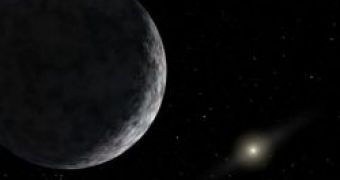The newly discovered 10th planet, 2003 UB313, is looking more and more like one of the solar system's major players. It has the heft of a real planet (latest estimates put it at about 20 percent larger than Pluto), a catchy code name (Xena, after the TV warrior princess), and a Guinness Book-ish record of its own (at about 97 astronomical units-or 9 billion miles from the sun-it is the solar system's farthest detected object).
And, astronomers from the California Institute of Technology and their colleagues have now discovered, it has a moon.
The moon, 100 times fainter than Xena and orbiting the planet once every couple of weeks, was spotted on September 10, 2005, with the 10-meter Keck II telescope at the W.M. Keck Observatory in Hawaii by Michael E. Brown, professor of planetary astronomy, and his colleagues at Caltech, the Keck Observatory, Yale University, and the Gemini Observatory in Hawaii. A paper about the discovery was submitted on October 3 to Astrophysical Journal Letters.
"Since the day we discovered Xena, the big question has been whether or not it has a moon," says Brown. "Having a moon is just inherently cool-and it is something that most self-respecting planets have, so it is good to see that this one does too."
Brown estimates that the moon, nicknamed "Gabrielle"-after the fictional Xena's fictional sidekick-is at least one-tenth of the size of Xena, which is thought to be about 2700 km in diameter (Pluto is 2274 km), and may be around 250 km across.
Most objects in the Kuiper Belt, the massive swath of miniplanets that stretches from beyond Neptune out into the distant fringes of the solar system, are about half rock and half water ice. Since a half-rock, half-ice surface reflects a fairly predictable amount of sunlight, a general estimate of the size of an object with that composition can be made. Very icy objects, however, reflect a lot more light, and so will appear brighter-and thus bigger-than similarly sized rocky objects.
The researchers discovered Gabrielle using Keck II's recently commissioned Laser Guide Star Adaptive Optics system.
The new system also allowed Brown and his colleagues to observe a small moon in January around 2003 EL61, code-named "Santa," another large new Kuiper Belt object.
Previously, researchers believed that Kuiper Belt objects obtained moons through a process called gravitational capture, in which two formerly separate objects moved too close to one another and become entrapped in each other's gravitational embrace. This was thought to be true of the Kuiper Belt's small denizens-but not, however, of Pluto. Pluto's massive, closely orbiting moon, Charon, broke off the planet billions of years ago, after it was smashed by another Kuiper Belt object. Xena's and Santa's moons appear best explained by a similar origin.
This week, Softpedia would like to know your opinion on gaming consoles. What is your favorite console you either own or you are planning to buy? Are you an Xbox fan or a Playstation fan? Has Xbox360 convinced you it's time to buy one? Or you'll wait for the PS3? Express your opinion here.

 14 DAY TRIAL //
14 DAY TRIAL //